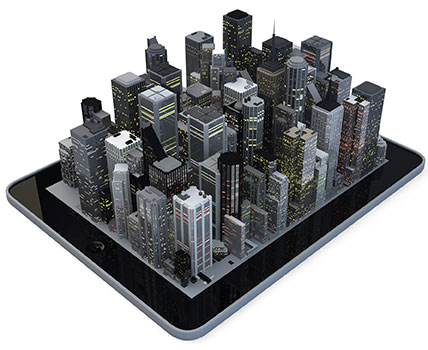City objective: Smart service management
More than ever, we live in a time of change, organizational transformation and digital mutations. Indeed, the digitalization era is well underway, and its effects are felt at all levels of society. Companies have already started moving forward, while several institutions and organizations are considering it or thinking about implementing their changes. Whether we are referring to the Internet, Big Data, the development of cloud technology, or increasing mobility needs, there is no doubt that digital advances will have a direct impact on people’s daily lives and the interactions they have with public institutions.
Beyond the modern trends such as engagement through gamification or citizen data management, a global notion is being introduced to specify technology objectives that will support the development of the “smart city” concept, as it refers to administrative, economic, environmental or social development to meet the constantly changing needs of institutions, corporations and citizens. According to Rudolf Giffinder, from the Centre of Regional Science at Vienna University, the concept must work hand-in-hand with a clear strategic vision. With this concept comes new dimensions of intelligence, coupled with new bases such as regional competitiveness, transport economy and information technology.
Information and communication technology is an important vector and may contribute directly to the achievement of collective goals. Here is some elements to help deliver better municipal IT services.
A smart city must provide smart services
Municipalities provide a multitude of services, from public works to law enforcement, garbage collection to delivery permits. In order to achieve smart city standards (and compete with other regional municipalities), the municipal administration has to offer smart services. The intelligence and quality of these services entail improvements not only in terms of digitization of public services but also at the level of interactive user relationships and the collaborative aspect of the process.
Thus, connecting citizens to municipal services is a key issue. Service management (ITSM) and appropriate software solutions play an important role in the emergence of the continuity of said concept. Here are four ITSM prerequisites that support the connection between citizens and the municipality associated with the delivery of municipal services:
- The implementation of adequate service categorization
- Efficient distribution of service requests to the relevant teams
- The creation of tasks, customized requests and reports relevant to the operationalization of services
- Careful planning of request-related follow-ups
However, these essential elements do not ensure complete delivery of so-called smart services. A centralized management and activation optimally supports this optimal citizen connection.
Centralized Service Management
The development and integration of technology systems used for digitizing various citizen services is at the heart of management measures adopted by the modern city. In fact, access to these services could also benefit from centralization to facilitate user experience and request processing. Indeed, through centralized management of requests and their publication via citizen self-service portals, requests are easily forwarded and quickly processed. This promotes customer satisfaction through automatic monitoring associated with the resolution of their request. This centralization has many benefits; however, it is important to always consider interoperability with existing systems and environments.
This citizen satisfaction must become a predominant criterion in the delivery of public services of any kind. Furthermore, as government agencies begin listening to residents, they are discovering new needs, trends and methods to facilitate request processing. We are now noticing several mobile applications being introduced that offer a request reporting and forwarding service to their city. In response to citizen initiatives and the widespread “on the go” lifestyle, this support allows the city to be closer to the individual.
Participation, transparency and information-sharing
As mentioned previously, this digital revival involves greater participation from all stakeholders, including citizens. Smart services must be part of a process of openness and transparency. The more participation we get from citizens, the more the municipality wins. Moreover, ITSM software solutions support this transparency through request-forwarding portals, allowing two-way communication between the technical resource used by the municipality and the citizen or internal applicant.
This collaboration can also extend to various industries, business sectors and social contexts. However, this transparency requires a greater dissemination of information to the public and must rely on effective democratization of technology for the benefit of the community. After all, the municipal goal is also about offering and managing intelligent services.






